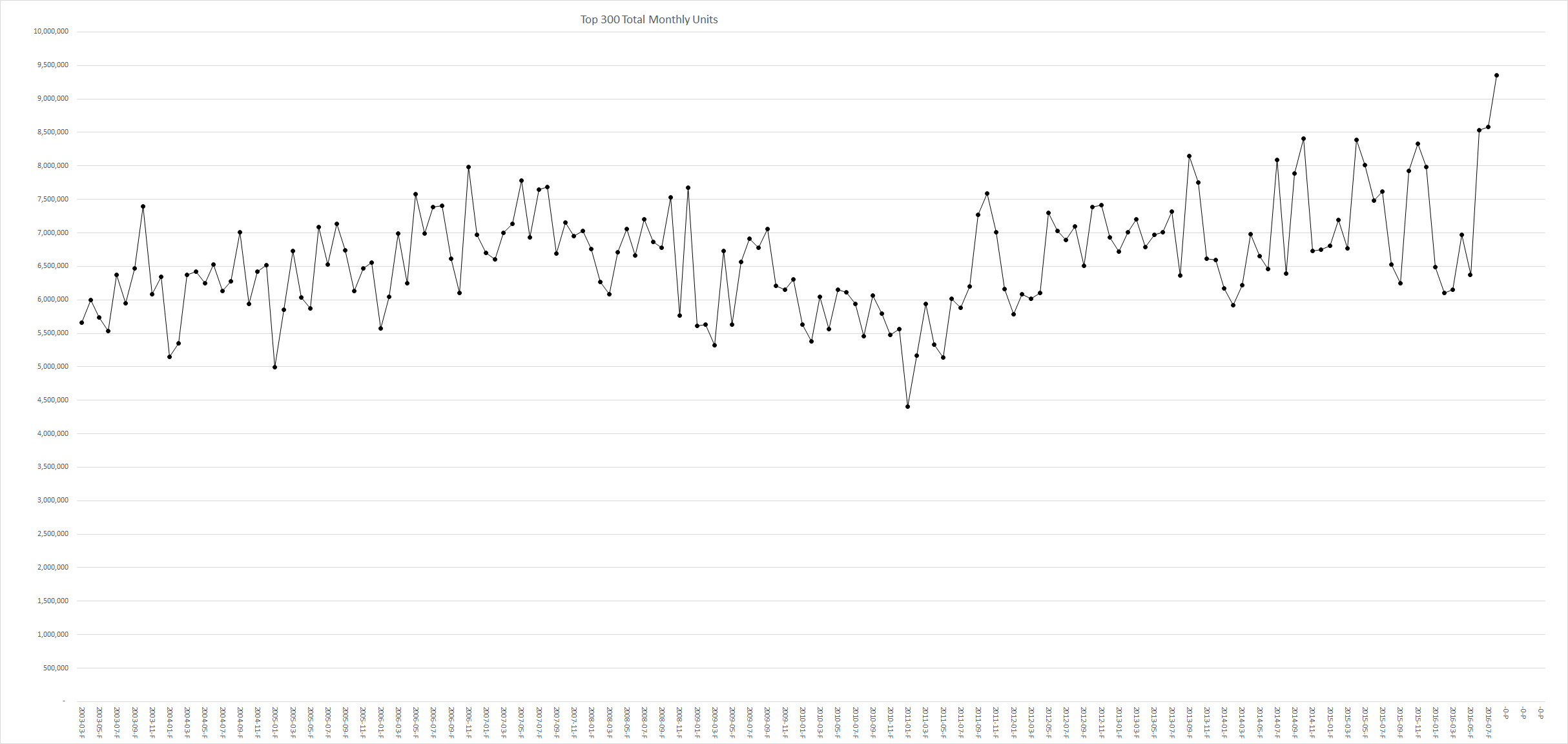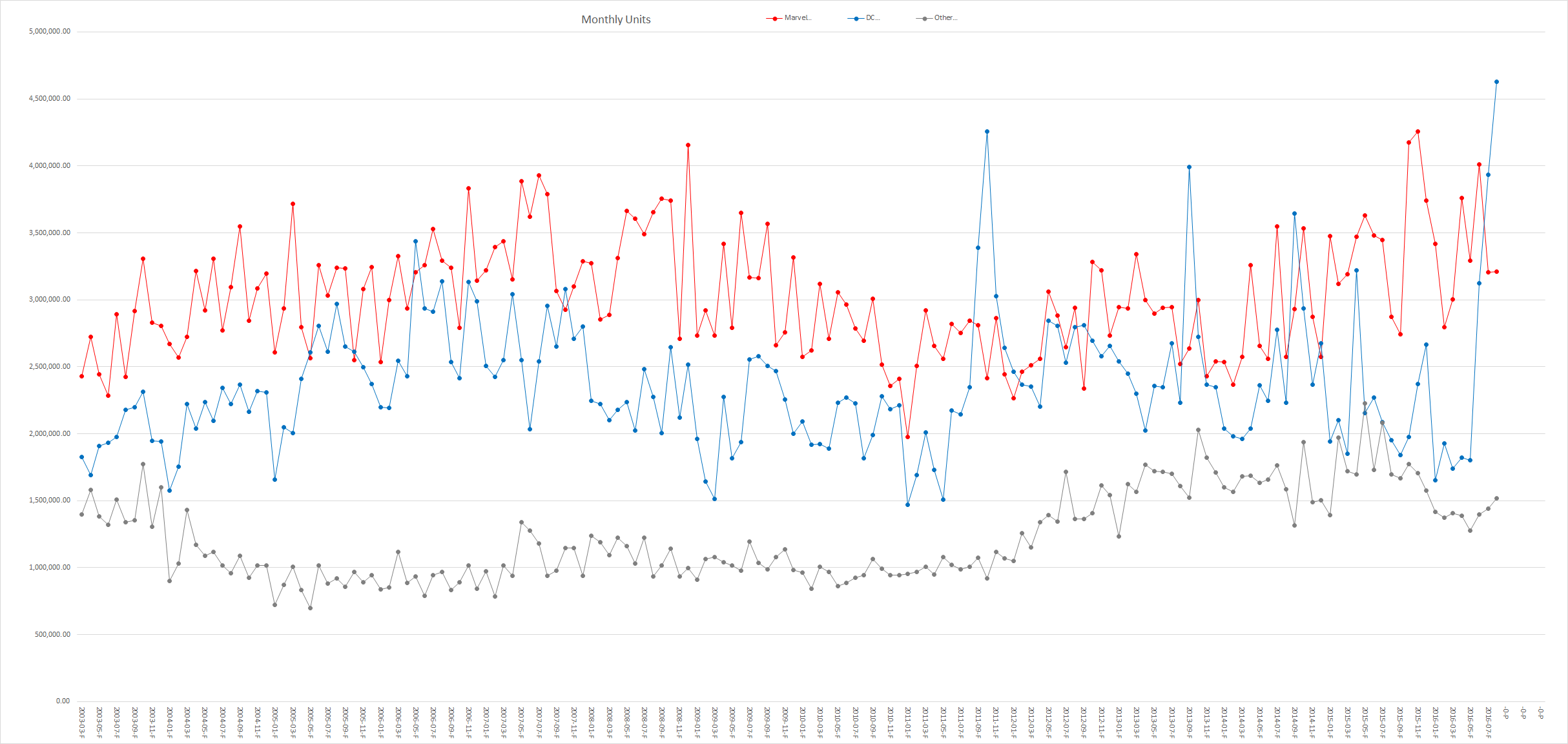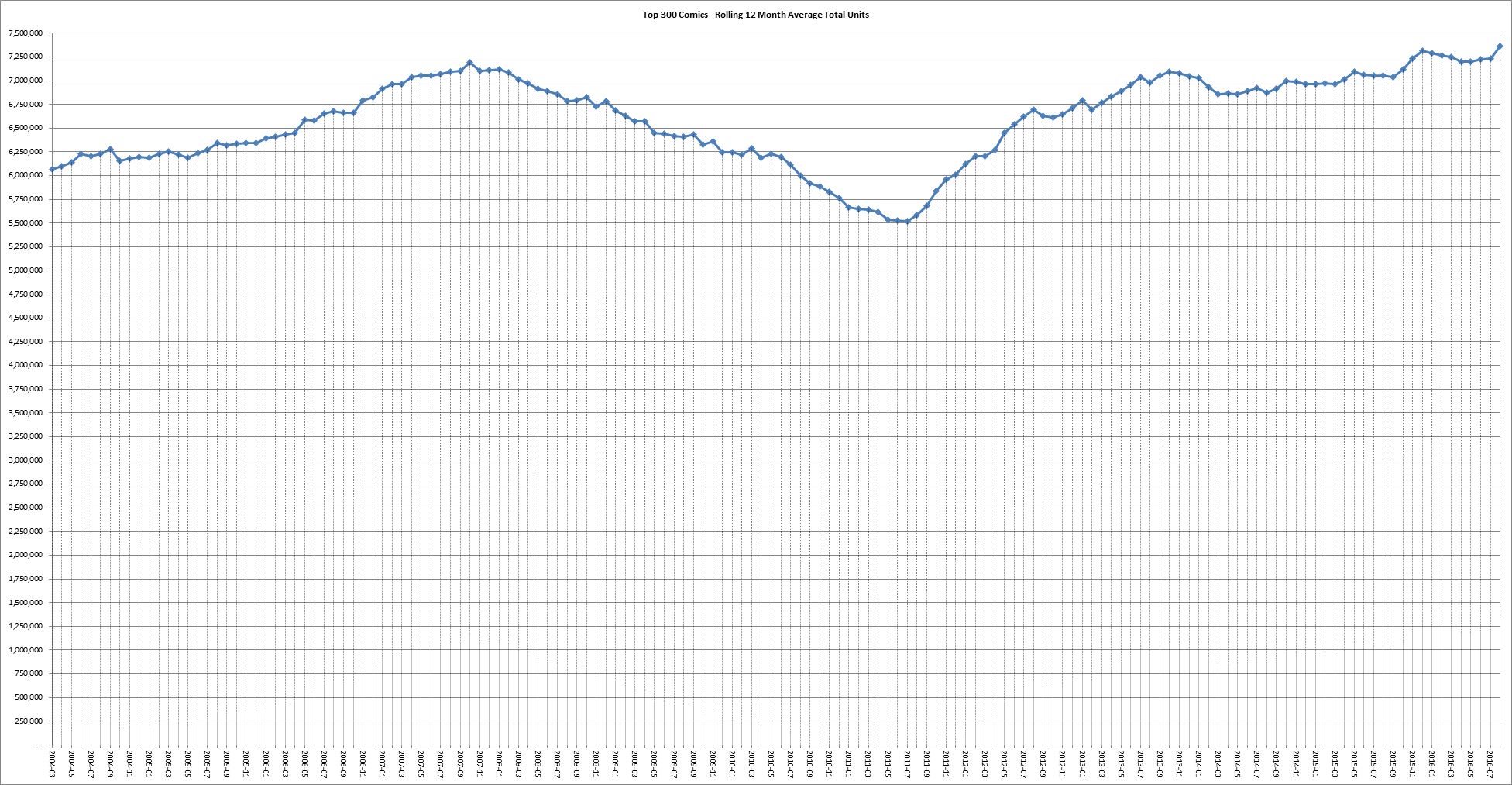Mayo Report for 2016-08

|

|
Top Comics List Top Comics Breakdown Top Trades List Top Trades Breakdown
August 2016 was the third record-breaking month in a row for the top 300 comics with 8,581,015 units. DC accounted for 49.46% of the total units for the top 300 comics, Marvel took another 34.33%, Image had 6.73%, IDW another 2.59%, Dark Horse had 1.77%. All of the publishers in the back half of Previews combined accounted for only 5.13% of the unit sales for the top 300 comics. Keep in mind that much of the material from the publishers in the back half of Previews often falls below the radar of the top 300 comics list which cut off at 5,496 units this month.
Record breaking sales for three months in a row is unprecedented during the final order era which started in March 2003 when Diamond switched from reporting what stores ordered to what was invoiced to stores. Prior to that point the data includes orders for comics which were never released. The data Diamond current releases measures what was actually sold to the retail stores. What this data does not measure is how those items sold at the stores to readers and collectors. This is sell-in data, not sell-through data. This is very important to keep in mind right now since there is a possibility that stores might have over-ordered and be sitting on too much stock. Hopefully that isn't the case and most likely it isn't. Since the Rebirth titles are returnable, stores aren't having to shoulder an unfair burden of risk on the DC titles. While that might not completely eliminate the risk to the retailers of over-ordering, DC can't be expected to do much more than that other than to produce comics which readers actually want to buy. So far, the data suggests the comics DC is publishing as part of the Rebirth initiative are pleasing the readership more than the previous comics.
The most obvious question is what is causing the record-breaking sales? The main cause is the Rebirth initiative at DC. Sales in the top 300 comics for DC have skyrocketed from 1,801,170 units in May 2016 to 4,626,873 units in August.
A similar spike in DC sales happened in September and October of 2011 with the New 52 relaunch of the DC Universe. But, as the chart clearly shows, the initial spike in sales for the New 52 was brief, lasting on a few months. The Rebirth sales spike has already exceeded the New 52 sales spike by a month and by about 370,686 units.
Eleven comics solder over 100,000 units with "Suicide Squad" #1 selling 217,672 units, "All-Star Batman" #1 selling 289,348 units and the most recent "Harley Quinn" #1 topping the list with around 359,957 units. To say those sales levels are not sustainable is both an understatement and hopefully could have gone unsaid. As proof of that, "Harley Quinn" #2 dropped 67.59% down to 116,651 units. The sales of "Batman" #4 of 152,985 units and "Batman" #5 of 142,142 units are on the high end of sustainable sales for that title.
This increase in sales at DC has not come at the expense of either Marvel or the other publishers. The implication is there are more spending dollars potentially available to comic books then are actually being spent. Had the Rebirth sales resulted in a loss of sales over at Marvel, for instance, we'd see the overall total for the top 300 comics doing the usual month-to-month fluctuations while the percentage going to DC grow while the percentage for Marvel shrank. We are seeing the percentage for Marvel drop over the last few months but that reflects a drop in unit sales from 4,009,721 units in June down to 3,211,315 units in August.
Initially, the drop in Marvel units over the past few months and the increase in DC units during the past few months might seem to imply DC has stolen sales from Marvel. This is where how you look at the data really matters. Looking at the month-to-month sales for the top 300 comics can be a little misleading since those results can fluctuate wildly based on which titles are and are not published in each given month. For instance, two issues on "Civil War II" were released in July which none were released in August which could equate to what would look like a loss of around a quarter-million units for Marvel from the month-to-month perspective. But readers didn't drop "Civil War II" from their reading lists. It just didn't come out. Looking at the issue-to-issue deltas for Marvel titles in August, we don't really see any sort of mass exodus from Marvel which would be the case if DC was really stealing sales from Marvel.
We do see some losses over at Marvel, one or two of which are staggering like the 59.60% drop on "Amazing Spider-Man" #17. Again, context matters. "Amazing Spider-Man" #15 sold around 93,580 units. "Amazing Spider-Man" #16 increased by 98.06% resulting in estimates sales of 185,341 units. With that context, the drop of 59,60% in "Amazing Spider-Man" #17 down to 74,869 units is clearly a course correction after a one issue spike in sales. A variant cover version of "Amazing Spider-Man" #16 was included in the Marvel Collector Corps subscription box in August and there were two ComicXposure variant covers and a Marvel Tsum-Tsum variant.
Variant covers and placement in subscription boxes are a common tactic to bump up sales. There is another sales tactic which sometimes works on a particular handful of titles and seemingly only on those titles: starting a new story arc. "The Walking Dead" #157 started "The Whisperer War" storyline and the issue increased by 27.94% from 76,354 units to 97,689 units. This is a new high water mark for the title if you exclude the issues with variant covers. Is this a single issue spike in sales or it could be setting the sales level for the story arc? On most titles, a single issue spike is the safe bet. For "The Walking Dead" and particularly on a storyline featuring one of the more popular characters in the series, there is a strong chance we are seeing readers jump from the trades to the issues.
The rolling 12-month average for the top 300 comics is strong than it has even been during the final order era. Not only are sales strong, they might be even strong since potentially over a million units went unreported in August because of possible returns (presuming a 20% reduction in the reported units). Potentially a total of around 10,524,981 individual comic books shipped to comic book stores in August for the top 300 comics. Overall sales will probably remain strong as long as the sales of the Rebirth titles from DC stay strong. Of the top 50 comics, 39 of them were DC Rebirth titles. Marvel has been producing comics which sell well for years. If DC can get into that mode, which they seem to be doing, that provides a very healthy sales environment for all of the other publishers which is good for everyone.





